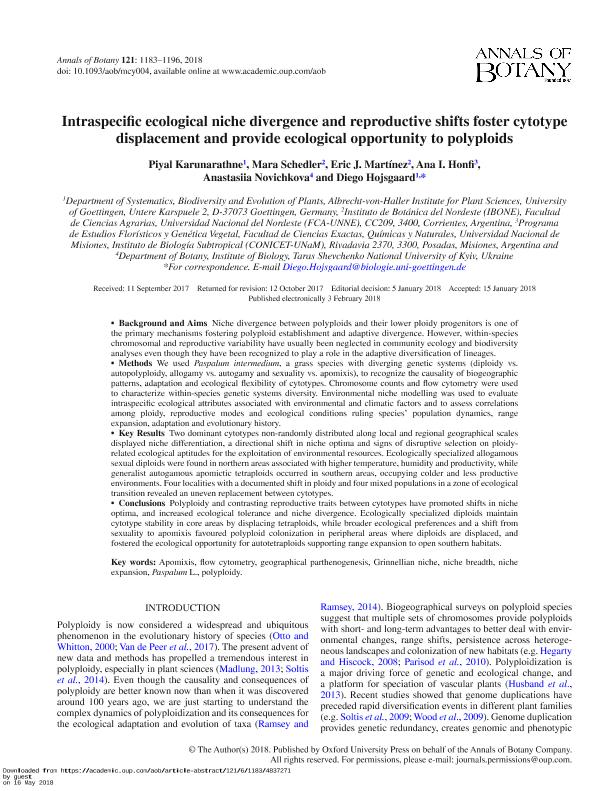Mostrar el registro sencillo del ítem
dc.contributor.author
Karunarathne, Piyal
dc.contributor.author
Schedler, Mara

dc.contributor.author
Martínez, Eric Javier

dc.contributor.author
Honfi, Ana Isabel

dc.contributor.author
Novichkova, Anastasiia
dc.contributor.author
Hojsgaard, Diego Hernan

dc.date.available
2019-10-28T20:30:42Z
dc.date.issued
2018-05
dc.identifier.citation
Karunarathne, Piyal; Schedler, Mara; Martínez, Eric Javier; Honfi, Ana Isabel; Novichkova, Anastasiia; et al.; Intraspecific ecological niche divergence and reproductive shifts foster cytotype displacement and provide ecological opportunity to polyploids; Oxford University Press; Annals of Botany; 121; 6; 5-2018; 1183-1196
dc.identifier.issn
0305-7364
dc.identifier.uri
http://hdl.handle.net/11336/87431
dc.description.abstract
Background and Aims Niche divergence between polyploids and their lower ploidy progenitors is one of the primary mechanisms fostering polyploid establishment and adaptive divergence. However, within-species chromosomal and reproductive variability have usually been neglected in community ecology and biodiversity analyses even though they have been recognized to play a role in the adaptive diversification of lineages. Methods We used Paspalum intermedium, a grass species with diverging genetic systems (diploidy vs. autopolyploidy, allogamy vs. autogamy and sexuality vs. apomixis), to recognize the causality of biogeographic patterns, adaptation and ecological flexibility of cytotypes. Chromosome counts and flow cytometry were used to characterize within-species genetic systems diversity. Environmental niche modelling was used to evaluate intraspecific ecological attributes associated with environmental and climatic factors and to assess correlations among ploidy, reproductive modes and ecological conditions ruling species' population dynamics, range expansion, adaptation and evolutionary history. Key Results Two dominant cytotypes non-randomly distributed along local and regional geographical scales displayed niche differentiation, a directional shift in niche optima and signs of disruptive selection on ploidyrelated ecological aptitudes for the exploitation of environmental resources. Ecologically specialized allogamous sexual diploids were found in northern areas associated with higher temperature, humidity and productivity, while generalist autogamous apomictic tetraploids occurred in southern areas, occupying colder and less productive environments. Four localities with a documented shift in ploidy and four mixed populations in a zone of ecological transition revealed an uneven replacement between cytotypes. Conclusions Polyploidy and contrasting reproductive traits between cytotypes have promoted shifts in niche optima, and increased ecological tolerance and niche divergence. Ecologically specialized diploids maintain cytotype stability in core areas by displacing tetraploids, while broader ecological preferences and a shift from sexuality to apomixis favoured polyploid colonization in peripheral areas where diploids are displaced, and fostered the ecological opportunity for autotetraploids supporting range expansion to open southern habitats.
dc.format
application/pdf
dc.language.iso
eng
dc.publisher
Oxford University Press

dc.rights
info:eu-repo/semantics/openAccess
dc.rights.uri
https://creativecommons.org/licenses/by/2.5/ar/
dc.subject
APOMIXIS
dc.subject
FLOW CYTOMETRY
dc.subject
GEOGRAPHICAL PARTHENOGENESIS
dc.subject
GRINNELLIAN NICHE
dc.subject
NICHE BREADTH
dc.subject
NICHE EXPANSION
dc.subject
PASPALUM L.
dc.subject
POLYPLOIDY
dc.subject.classification
Genética y Herencia

dc.subject.classification
Ciencias Biológicas

dc.subject.classification
CIENCIAS NATURALES Y EXACTAS

dc.subject.classification
Biología Reproductiva

dc.subject.classification
Ciencias Biológicas

dc.subject.classification
CIENCIAS NATURALES Y EXACTAS

dc.title
Intraspecific ecological niche divergence and reproductive shifts foster cytotype displacement and provide ecological opportunity to polyploids
dc.type
info:eu-repo/semantics/article
dc.type
info:ar-repo/semantics/artículo
dc.type
info:eu-repo/semantics/publishedVersion
dc.date.updated
2019-10-22T17:28:46Z
dc.identifier.eissn
1095-8290
dc.journal.volume
121
dc.journal.number
6
dc.journal.pagination
1183-1196
dc.journal.pais
Reino Unido

dc.journal.ciudad
Oxford
dc.description.fil
Fil: Karunarathne, Piyal. Universität Göttingen; Alemania
dc.description.fil
Fil: Schedler, Mara. Consejo Nacional de Investigaciones Científicas y Técnicas. Centro Científico Tecnológico Conicet - Nordeste. Instituto de Botánica del Nordeste. Universidad Nacional del Nordeste. Facultad de Ciencias Agrarias. Instituto de Botánica del Nordeste; Argentina
dc.description.fil
Fil: Martínez, Eric Javier. Consejo Nacional de Investigaciones Científicas y Técnicas. Centro Científico Tecnológico Conicet - Nordeste. Instituto de Botánica del Nordeste. Universidad Nacional del Nordeste. Facultad de Ciencias Agrarias. Instituto de Botánica del Nordeste; Argentina
dc.description.fil
Fil: Honfi, Ana Isabel. Consejo Nacional de Investigaciones Científicas y Técnicas. Centro Científico Tecnológico Conicet - Nordeste. Instituto de Biología Subtropical. Instituto de Biología Subtropical - Nodo Posadas | Universidad Nacional de Misiones. Instituto de Biología Subtropical. Instituto de Biología Subtropical - Nodo Posadas; Argentina
dc.description.fil
Fil: Novichkova, Anastasiia. No especifíca;
dc.description.fil
Fil: Hojsgaard, Diego Hernan. Universität Göttingen; Alemania. Consejo Nacional de Investigaciones Científicas y Técnicas. Centro Científico Tecnológico Conicet - Nordeste. Instituto de Botánica del Nordeste. Universidad Nacional del Nordeste. Facultad de Ciencias Agrarias. Instituto de Botánica del Nordeste; Argentina
dc.journal.title
Annals of Botany

dc.relation.alternativeid
info:eu-repo/semantics/altIdentifier/doi/http://dx.doi.org/10.1093/aob/mcy004
dc.relation.alternativeid
info:eu-repo/semantics/altIdentifier/url/https://academic.oup.com/aob/article/121/6/1183/4837271
Archivos asociados
